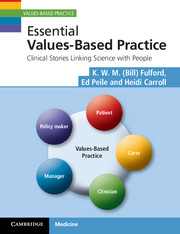Book contents
- Frontmatter
- Review quotes
- Contents
- Foreword
- Acknowledgements
- A bold claim to start this book
- Prologue: linking science with people
- Part 1 Values, individuals and an overview of values-based practice
- Part 2 The clinical skills for values-based practice
- Part 3 Relationships in values-based practice
- 8 “Best” in breast cancer: clinician values and person-centered care
- 9 Risks in safeguarding children: team values as well as skills
- Part 4 Science and values-based practice
- Part 5 Bringing it all together
- Postcript: the small change of care
- A bold claim to end this book
- Appendix A Values-based practice summary and definitions of key terms
- Appendix B Values-based practice teaching framework
- Index
8 - “Best” in breast cancer: clinician values and person-centered care
Published online by Cambridge University Press: 05 June 2012
- Frontmatter
- Review quotes
- Contents
- Foreword
- Acknowledgements
- A bold claim to start this book
- Prologue: linking science with people
- Part 1 Values, individuals and an overview of values-based practice
- Part 2 The clinical skills for values-based practice
- Part 3 Relationships in values-based practice
- 8 “Best” in breast cancer: clinician values and person-centered care
- 9 Risks in safeguarding children: team values as well as skills
- Part 4 Science and values-based practice
- Part 5 Bringing it all together
- Postcript: the small change of care
- A bold claim to end this book
- Appendix A Values-based practice summary and definitions of key terms
- Appendix B Values-based practice teaching framework
- Index
Summary
Topics covered in this chapter
The story of Brenda Forest described in this chapter shows the importance of values (alongside evidence) in tackling two kinds of problem presented by person-centered practice: problems of mutual understanding and problems of conflicting values.
Other topics include:
The many varieties of person-centered medicine
Body image, sexuality and (desired) outcomes in women with breast cancer
NICE guidelines on the management of early breast cancer
Jainism and Gujarati culture.
Take-away message for practice
Genuinely person-centered practice means person-values-centered practice.
Values-based practice is very far from being alone in promoting a person-centered approach to clinical decision-making in medicine. Indeed, although there is a sense in which medicine has always been centered on people (what else could medicine be about but people), person-centered has become one of the buzz words of current clinical practice, following the work of McWhinney's group (Stewart et al., 2003).
Like many such buzz words, however, as we saw in Chapter 1, exactly what it means to be “person-centered” varies widely with context. In therapeutics, “personalized medicine” means tailoring drugs and other treatments to the individual, including, in principle at least, the individual's unique genetic profile. With breast cancer, which is the focus of this chapter, there have been major developments in recent years towards more personalized approaches in this sense. Again, terms like “patient-led” and “expert patient” are scattered liberally in current policy and service developments, not to mention research.
- Type
- Chapter
- Information
- Essential Values-Based PracticeClinical Stories Linking Science with People, pp. 99 - 114Publisher: Cambridge University PressPrint publication year: 2012

